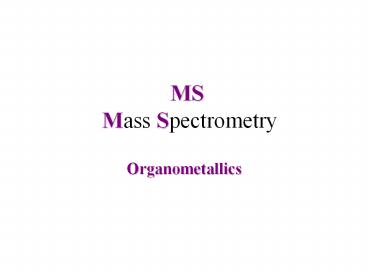MS Mass Spectrometry - PowerPoint PPT Presentation
1 / 22
Title:
MS Mass Spectrometry
Description:
MS. Mass Spectrometry. Organometallics. Centro de espectrometr a de masa ... Many species are intractable to mass spectrometry for one of a number of reasons. ... – PowerPoint PPT presentation
Number of Views:151
Avg rating:3.0/5.0
Title: MS Mass Spectrometry
1
MS Mass Spectrometry
- Organometallics
2
Centro de espectrometría de masa (Harvard)
- General Information
- The word that best describes the mass
spectrometry of inorganic and Organometallic
molecules is "difficult". - Many species are intractable to mass spectrometry
for one of a number of reasons. To see our
recommendations for Organometallic, click here.
Recommendations We recommend you confer with
your friendly local mass spectrometrist before
preparing any organometallic or inorganic samples
for mass spectrometry.
3
Métodos de Ionización (los más usuales)
- EI (Impacto Electrónico) se volatiliza la
muestra y se ioniza con un haz de electrones. M.
y fragmentos - FAB (Fast Atom Bombardment) se coloca la muestra
en una matriz líquida (un alcohol) y se impacta
con un haz de átomos de Xe. (MH) (MNa),
(Mmatriz), fragmentos, etc - MALDI (Matrix-Assisted Laser Desorption/Ionization
) se coloca la muestra en una matriz sobre un
metal y se impacta con un laser. Muy usado para
péptidos y proteínas. - ESI (ElectroSpray Ionization) se disuelve la
muestra, se pasa por un capilar a 5 kV, que la
dispersa en microgotas. MnHn, MNa, etc.
4
Isotope patterns
Aluminium Bromide
AlBr 27Al 100 79Br 51 81Br 49
5
Isotope patterns
63Cu35Cl
63Cu 69.1
35Cl 75.5 37Cl 24.5
63Cu37Cl
65Cu35Cl
65Cu 30.9
65Cu37Cl
Abundance of first isotope peak M .691 x .755
.521
For next isotope peak M2 .691 x .245 .169
.403
.309 x .755 .233
For next isotope peak M4 .309 x .245 .076
6
Poly-isotopic metals
Metal isotope pattern are distorted by 13C and 2H
7
Poly-isotopic metals
When more than one metal is present pattern is
affected in a predictable way
8
Ru1
(bpy)(tpy)RuN2ArN2Ru(bpy)(tpy)?
Ru2
9
Reacciones ion-molécula
Se producen ocasionalmente, dando lugar a iones
de MAYOR masa que el ion molecular.
Cr(CO)6 Cr(CO)6 --gt Cr(CO)10 2 CO
10
Fragmentation
- The charge is likely to remain on
Metal-containing fragment
M Ln-1 L
MLn
L M Ln-1
Less likely
- Rearrangement involving hydrogen migration are
frequent
(M gt Si, Ge, Sn, Pb)
11
Fragmentation
- Migration of Halogens is very common
M (C6F5)3
(C6F5)2 Sn F C6F4
M gt Si, Ge, Sn, Pb
- Migration of Alkyl to metal is also common
Transfer of R is influence by electronegativity
of the R group
12
Rearrangement process
McLafferty type of rearrangement involving
metal instead of H
This rearrangement depends on readiness of metal
to become pentacoordinate (using its d-orbitals)
13
Metal Carbonyls (Co)
14
Metal Carbonyls (Fe)
15
Metal Carbonyls (Fe)
16
Carbonyl halide compounds
Terminal
Bridging
17
Carbonyl halide compounds
Terminal
Loss of CO and X occur with equal ease
Bridging
Loss of CO occur stepwise with retention of M2X2
than further X loss can occur
18
Cs2IrCl5CO (ESI-MS(-))
IrCl4CO-
IrCl4-
IrCl5CO2-
19
MSMS 199 (IrCl5CO2-)
IrCl4CO-
IrCl4-
20
FTMS
- Fourier transform mass spectrometry, is a type of
mass spectrometer for determining the m/z of ions
based on the cyclotron frequency of the ions in a
fixed magnetic field. - The ions are trapped in a magnetic field with
electric trapping plates where they are excited
to a larger cyclotron radius by an oscillating
electric field perpendicular to the magnetic
field. The excitation also results in the ions
moving in phase (in a packet). The signal is
detected as an image current on a pair of plates
which the packet of ions passes close to as they
cyclotron. The resulting signal is called a free
induction decay (FID), transient or interferogram
that consists of a superposition of sine waves.
The useful signal is extracted from this data by
performing a Fourier transform to give a mass
spectrum.
21
Ru(CpPh5)2BrO
22
(CpPh5)Ru(CO)22(PhCH2O)































